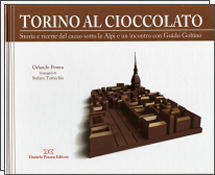| TORINO AL CIOCCOLATO Storia e ricette del cacao sotto le Alpi e un incontro con Guido Gobino |
PREFAZIONE Se il prestigio internazionale dell'Italia oggi si fonda principalmente su tre "F" (Food, Fashion and Ferrari) bisognerebbe forse aggiungere una "C", come Chocolate. Nel cioccolato di alta qualità, il nostro paese ha pochi rivali nel mondo. Il segreto è sempre lo stesso: un mix fra ricerca della migliore materia prima, produzione accurata in piccoli laboratori specializzati, alta tecnologia quando serve, gusto ed eleganza d'immagine. In Italia i poli del cioccolato artigianale più raffinato sono tre: la Toscana, nella zona attorno a Pisa, Pontedera e Prato; la Sicilia, con la scuola di Modica, in provincia di Ragusa, dove si fa il cioccolato senza "concaggio", lasciando cioè la pasta granulosa e ricca di cristalli di zucchero, come nei tempi antichi; infine, ma non ultimo, il Piemonte, con il suo capoluogo, Torino, dove la concentrazione di cioccolatieri di qualità è tra le più elevate, e dove, si può dire, il moderno cioccolato è nato, facendo scuola anche agli svizzeri. Torino, in particolare, è la madre del cioccolato gianduia, ottenuto miscelando pasta di nocciole a quella di cacao. Una delizia che ora molti hanno imitato, ma ha la sua origine tutta qui, un secolo e mezzo fa. Per raccontare questa storia, oltre ad un panorama generale, ho pensato di dare voce a chi dell'arte cioccolatiera in Piemonte è oggi il protagonista indiscusso: Guido Gobino, l'artigiano raffinato che meglio ha rilanciato in Italia e nel mondo l'immagine del cioccolato torinese e non solo. Si può dire che l'intera italian way of chocolate passa oggi per il suo nitido laboratorio di Via Cagliari, in un antico sobborgo della prima capitale d'Italia, e per la nuova rivendita-sala degustazione del settecentesco Palazzo Carpano, in Via Lagrange, quasi davanti all'Accademia delle Scienze e al Museo Egizio. L'incontro con Guido Gobino rappresenta anche l'occasione per raccontare il ruolo centrale che i cicolaté torinesi e piemontesi hanno esercitato negli ultimi due secoli, o poco meno. Senza di loro la storia del cioccolato e dell'industria dolciaria sarebbe stata diversa, non c'è dubbio. Ma in questo volume ho voluto anche ricordare che il cioccolato non è soltanto un dolce. [..] INDICE Prefazione Acqua Amara Theobroma La musica del cioccolato Guido Gobino: curioso dialogo sul cacao Tipi di cioccolato A pranzo col cioccolato Ricette |
PREFACE If the Italian prestige today is founded mainly on the three "F's" (Food, Fashion and Ferrari) maybe we should also add a "C" for Chocolate. In the high quality chocolate field, our country has very few rivals in the world. The secret is always the same, a mixture of research of the best raw essence, refined production in small-specialized laboratories, high technology when needed, taste and elegance of image. In Italy there are three main areas for the artisan chocolate. Tuscany, in the area around Pisa, Pontedera, Prato. Sicily with its school in Modica in the province of Ragusa, where the chocolate is made without "tanning", i.e. by retaining the granulated and rich paste of sugar crystals. And last, but not least, Piedmont, with its main town of Turin where the concentration of high quality chocolate producers is amongst the highest and where, we can say that the modern chocolate was born. Turin, in particular, is the birthplace of the Gianduia chocolate, which is made by mixing nuts and cacao paste. It is a delicacy that has been imitated by many but has its origin here one and a half centuries ago. To tell this story, besides a general background, I thought about talking to someone who is the undisputed protagonist of the chocolate making art, Guido Gobino. Hе is the artisan who re-launched, in Italy and the rest of the world, the image of Turin chocolate. The Italian way of producing chocolate goes through, today, its clean laboratory in Via Cagliari which is an ancient suburb of the first Italian capital and the new sell-tasting room of the 17th century, Carpano Palace, in Via Lagrange, almost opposite the Science Academy and the Egyptian Museum. The meeting with Guido Gobino represents also a chance to tell about the main role that Turin and Piedmont cicolatè had in the last two centuries. Without them the history of chocolate and of the sweet industry would have been very different without a doubt. But in this book I also wanted to remember that chocolate is not just a sweet. [..] INDEX Preface Bitter Water Theobroma The music of chocolate Guido Gobino: curious dialogue about cacao Types of chocolate Luncheon with chocolate Recipes |

|
|||
| ©1999-2025 Tutti i diritti riservati Cell +39 3490876581 Spedizioni corriere espresso in Italia P.IVA 01172300053 - Cod.Fisc. BSSVCN50C23B425R - REA AT-93224 |